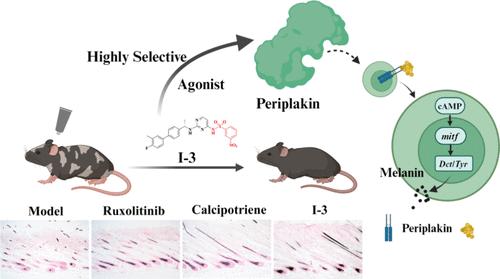以治疗白癜风的高选择性激动剂新型苯磺酰胺类药物的 Periplakin 为靶点
IF 6.8
1区 医学
Q1 CHEMISTRY, MEDICINAL
引用次数: 0
摘要
白癜风是全球最常见的色素脱失病因,免疫抑制治疗往往效果不佳且容易复发,因此确定新的治疗靶点至关重要。目前已发现并证实Periplakin(PPL)是导致白癜风相关色素脱失的关键因素。在此基础上,开发出了一系列选择性 PPL 激动剂,特别是苯磺酰胺类药物。其中,化合物 I-3 的疗效优于美国食品及药物管理局(FDA)批准的唯一一种治疗白癜风的药物--鲁索利替尼(ruxolitinib)。研究表明,I-3 可通过调节 PPL 增加 cAMP 水平,从而增强 MITF 的表达,MITF 是黑色素生物合成过程中的一个关键转录因子。此外,I-3 还能通过调节色氨酸代谢促进黑色素生成。总之,PPL是一个很有前景的药物靶点,而I-3由于其高选择性和良好的可药性,在未来治疗白癜风方面具有很大的潜力。本文章由计算机程序翻译,如有差异,请以英文原文为准。

Targeting Periplakin of Novel Benzenesulfonamides as Highly Selective Agonists for the Treatment of Vitiligo
Vitiligo is the most common cause of depigmentation worldwide, with immunosuppressive treatments often being inefficient and prone to recurrence, making it essential to identify new therapeutic targets. Periplakin (PPL) has been identified and confirmed as a key factor in vitiligo-related depigmentation. Based on this, a series of selective PPL agonists, specifically benzenesulfonamides, have been developed. Among these, compound I-3 exhibits superior efficacy compared to ruxolitinib, the only FDA-approved treatment for vitiligo. I-3 has been shown to increase cAMP levels by regulating PPL, which enhances MITF expression, a key transcription factor in melanin biosynthesis. Additionally, I-3 promotes melanin production by regulating tryptophan metabolism. In summary, PPL is a promising drug target, and I-3 has strong potential for future treatment of vitiligo due to its high selectivity and favorable druggability.
求助全文
通过发布文献求助,成功后即可免费获取论文全文。
去求助
来源期刊

Journal of Medicinal Chemistry
医学-医药化学
CiteScore
4.00
自引率
11.00%
发文量
804
审稿时长
1.9 months
期刊介绍:
The Journal of Medicinal Chemistry is a prestigious biweekly peer-reviewed publication that focuses on the multifaceted field of medicinal chemistry. Since its inception in 1959 as the Journal of Medicinal and Pharmaceutical Chemistry, it has evolved to become a cornerstone in the dissemination of research findings related to the design, synthesis, and development of therapeutic agents.
The Journal of Medicinal Chemistry is recognized for its significant impact in the scientific community, as evidenced by its 2022 impact factor of 7.3. This metric reflects the journal's influence and the importance of its content in shaping the future of drug discovery and development. The journal serves as a vital resource for chemists, pharmacologists, and other researchers interested in the molecular mechanisms of drug action and the optimization of therapeutic compounds.
 求助内容:
求助内容: 应助结果提醒方式:
应助结果提醒方式:


